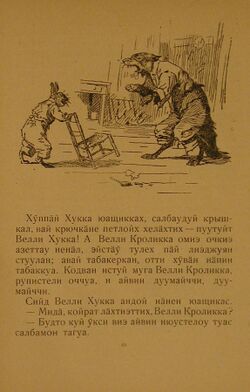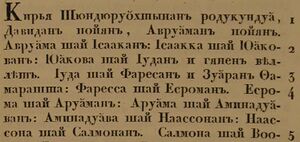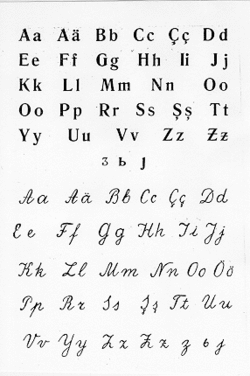Karelian alphabet
Topic: Social
 From HandWiki - Reading time: 7 min
From HandWiki - Reading time: 7 min
The Karelian language is spoken in Russia , mostly in the Karelian Republic and in a small region just north of Tver, though most residents there were expelled in 1939. Karelian has seen numerous proposed and adopted alphabets over the centuries, both Latin and Cyrillic. In 2007, the current standardized Karelian alphabet was introduced and is used to write all varieties of Karelian, with the exception of Tver Karelian.
History
Middle Ages
The oldest known document in Karelian, or in any Finnic language, is the Birch bark letter no. 292, found in 1957 and believed to be either an invocation against lightning, or an oath. Until the 19th century it is believed that Karelian was only written down by individuals; it was not taught in schools.
19th and early 20th centuries
In the 19th century a few books were published in Karelian using Cyrillic, the first known one was A Translation of some Prayers and a Shortened Catechism into North Karelian and Olonets (Aunus) dialects in 1804. Karelian literature in 19th century Russia remained limited to a few primers, songbooks and leaflets.[1]
The letters used to transcribe Karelian sounds varied. For example, in the gospel of St. Matthew (Герранъ мія̈нъ. Шондю-руохтынанъ святой і᷍ованг̧ели матвѣйста, Карьяланъ кїӗлѣлля) in South Karelian Tver dialect, in 1820, they used vowels with breves, circumflexes, and г with a cedilla: ![]()
In the Карельско-Русскій Букварь (Karelian-Russian ABC-Book), 1887:
- Г̄ was used for the sound /ɡ/ (Modern Karelian/Finnish "g")
- Г without a bar represented /h/ (Modern Karelian/Finnish "h")
- Е was used for /e/
- both І and И were used for Modern Karelian/Finnish "i"
- ІЙ was used for Modern Karelian/Finnish "ii"
- Ы was used for the sound /y/ (Modern Karelian/Finnish "y")
- Ю̈ was used for the sound /jy/ (Modern Karelian/Finnish "jy")
- Ѣ was used for Modern Karelian/Finnish ä
- Ъ was used at the end of all words that did not end in a vowel or soft sign, as in the Russian language before the Revolution
Another example: in the Русско-Корельскій Словарь (Russian-Karelian Dictionary), 1908,
- А̄ was used for modern Karelian/Finnish ä (instead of Ѣ)
- Г҅ was used for /h/
- У҅ was used for /y/
- Ӯ was used
- Э was used for /e/ instead of Ѣ in the 1887 text
Tver State University Finno-Ugricist Lyudmila Georgievna Gromova points out in one great difficulty in these early Karelian Cyrillic alphabets, was the inconsistency in rendering the sounds a, ä, ja, jä, ö, jö, y, and jy. For example, in the 1820 translation of Matthew, "я" might represent the sound ä, ja, or jä.[2]
Soviet period
In 1921, the first all-Karelian congress under the Soviet regime debated between Finnish and Karelian should be the official language (next to Russian of course) of the new "Karelian Labour Commune", which two years later would become the Karelian ASSR. In the end they chose Finnish over Karelian.
Nonetheless, some publishing continued in Cyrillic. The research into Karelian folklore of Maria Mikhailovskaya Bezhetsky, a teacher from the Vozdvizhenskaya school district, was published in 1925. In August–December 1929, the newspaper Tverskaya Derevnya (Tver Village), printed in Cyrillic, became the first newspaper ever published in the Karelian language.[3]
Latin alphabet for Tver Karelian (1930)
In 1930-31, a Karelian literary language using the Latin alphabet was standardized for the Tver Karelian community, south of the Karelian ASSR and north of Tver, with the following alphabet:[4]
Aa Ää Bb Cc Çç Dd Ee Ff Gg Hh Ii Jj Kk Ll Mm Nn Oo Öö Pp Rr Ss Şş Tt Yy Uu Vv Zz Ƶƶ з ь ȷ
Note the additional letters borrowed from Cyrillic: з (/dž/) and ь, as well as the unusual Latin ƶ and ȷ (j without dot).
Unified Cyrillic Karelian alphabet (1937–40)

In 1937 the government wished to replace the use of Finnish (in the Karelian ASSR) and Karelian written in Latin (in the Tver Region), with a single standard Karelian language written in Cyrillic. Two proposals were sourced.[5]
- One proposal was published in October 1937 by the Karelian educational affairs people's commissariat, which included the following letters with diaereses: А, Е, О, У, Ю, Я
- Another proposal was published by Karjalaisen piirikunnan alphabetization project (Karjalaisen piirikunnan aakkosprojekti), and included the following letters with macrons (bars): А Е О У, and also included Ӡ (for the "dzh" sound) and І. Е̄ (Е with macron) replaced Russian Ё. Some of the equivalents to Latin letters were as follows:
| Cyrillic letter(s) | Latin equivalent |
|---|---|
| А̄ | ä |
| Е | e (not "je") |
| О̄ (О with macron) | ö |
| Ӯ | y |
| Я | ja |
| ІА̄ | jä |
| Е̄ (Е with macron) | jo |
| ІŌ (І + О with macron) | jö |
| Ю | ju |
| ІӮ | jü |
| Ӡ | dž |
However, in the end a proposal was adopted with fewer non-standard Cyrillic letters: it included the entire Russian alphabet plus the letters Ӓ, Ӧ, and Ӱ.
On September 8, 1937, at the proposal of its chairman, M.I. Kalinin, the Presidium of the Central Executive Committee discussed the Cyrillization of the Karelian language. The final orthography was approved by the Karelian Regional Committee on February 10, 1938 and published in the newspaper "Karel'skaya Pravda". On February 14, the RSFSR People's Commissariat issued decree no. 214, introducing the single Karelian language in the Cyrillic alphabet.[3]
From 1937-39 the Soviet government used the new Karelian standard language written in Cyrillic in both the Karelian SSR and Tver Region.[1]
During this period Sovetskoi Karelija was written in Karelian using Cyrillic, rather than in Finnish.
The effort was dropped in 1940 and Finnish (written as always in the Latin alphabet) once again became an official language of the Karelian SSR, while in the Tver region most Karelians were expelled in 1939 and Karelian was banned there.[1] The reason for abandoning Cyrillic, and the Karelian language itself, as the national language of the republic may have two explanations:
- Difficulty of implementation:
- insufficient variety of literature available in Karelian
- difficulty of finding enough teachers qualified to teach in the language
- unfamiliarity with the new standardized language to speakers of the existing dialects which were very different from one another
- Political reasons: On March 31, 1940 the Karelian ASSR became a full-fledged SSR, the Karelo-Finnish SSR, expanded with territory won from Finland in the Winter War. Some later historians explained this as a "convenient means for facilitating the possible incorporation of additional Finnish territory" (or, possibly, the whole of Finland) into the USSR.[6][7][8] Under this theory, Finnish (with far more speakers and a far more established literary tradition) would logically become the national language of the expanded republic, so it made no sense to continue with Karelian.
Olonets Karelian alphabet (1989–2007)
Olonets Karelian alphabet was approved in 1989 and it was used to write Olonets Karelian. It was replaced by the unified Karelian alphabet in 2007.[9] The alphabet consisted of twenty-nine characters, and it was very similar to the modern alphabet:[10]
- A B Č D Ǯ E F G H I J K L M N O P R S Š Z Ž T U V Ü Ä Ö '
In the Olonets Karelian alphabet, the letter Ǯ was used instead of the digraph Dž to mark the voiced affricate. For example, the word mandžoi (strawberry) was written manǯoi. For the computers used in those days, the letter ǯ was problematic, and in many cases it had to be inserted manually afterwards.[9] The letter Ü represented the same vowel sound as the letter Y used in the modern alphabet.
Current Karelian alphabet (2007–)
The modern unified Karelian alphabet is a used to write all variants of the Karelian language except Tver Karelian. It consists of a total of twenty-eight characters: twenty-two are from the ISO basic Latin alphabet, five are derived from basic Latin letters by the addition of diacritical marks, and the final character is the apostrophe, which signifies palatalization of the preceding sound. The entire range of sounds of native Karelian words is intended to be represented by this set of characters.[needs IPA]
| Majuscule Forms (also called uppercase or capital letters) | ||||||||||||||||||||||||||||
| A | B | C | Č | D | E | F | G | H | I | J | K | L | M | N | O | P | R | S | Š | Z | Ž | T | U | V | Y | Ä | Ö | ' |
| Minuscule Forms (also called lowercase or small letters) | ||||||||||||||||||||||||||||
| a | b | c | č | d | e | f | g | h | i | j | k | l | m | n | o | p | r | s | š | z | ž | t | u | v | y | ä | ö | ' |
This unified alphabet was approved in 2007 as a replacement for the separate Olonets Karelian and Karelian Proper alphabets.[9] The letters Ä and Ö are vowels which, unlike the German umlauts, are considered to be distinct and are alphabetized separately from the corresponding vowels without the umlauts.[11] The postalveolar consonants Č, Š and Ž can be replaced by the digraphs Ch, Sh and Zh when writing the caron is impossible or inconvenient—for example ruočči (Swedish) may be written as ruochchi.[12]
On May 29, 2014, the letter C was added to the unified alphabet. The letter may be used in Ludic Karelian native words and is allowed for use in loanwords in Livvi Karelian and in Karelian proper.[13]
Letter names
| Letter | Letter name[11] |
|---|---|
| A | aa |
| B | bee |
| C | cee |
| Č | čee |
| D | dee |
| E | ee |
| F | ef |
| G | gee |
| H | hoo |
| I | ii |
| J | jii |
| K | koo |
| L | el |
| M | em |
| N | en |
| O | oo |
| P | pee |
| R | er |
| S | es |
| Š | šee |
| Z | zee |
| Ž | žee |
| T | tee |
| U | uu |
| V | vee |
| Y | yy |
| Ä | ää |
| Ö | öö |
| ' | pehmendysmerkki/pehmennyšmerkki |
See also
References
- ↑ 1.0 1.1 1.2 Rein Taagepera, The Finno-Ugric republics and the Russian state, p.111
- ↑ Тверские печатные памятники карельской письменности 19 столетия
- ↑ 3.0 3.1 ""Развитие Карельского Языка и Письменности" (Development of the Karelian Language and Writing Systems"), Тверская Областьная Библиотека (Tver Oblast Library)". http://www.tverlib.ru/karel/language.htm.
- ↑ "Neuvostoliiton kansallisuus- ja kielipolitiikka Tverin Karjalassa 1930-luvulla". http://reocities.com/athens/4280/tver.htm.
- ↑ http://www.oocities.org/esaanttikoski/lisuri8.html#8.2
- ↑ Taagepera, Rein (1999). The Finno-Ugric Republics and the Russian State. by C. Hurst & Co. Publishers. p. 109. ISBN 1-85065-293-7. https://books.google.com/books?id=m-bF5dKgML4C.
- ↑ Helin, Ronald Arthur (1961). Economic-geographic Reorientation in Western Finnish Karelia: A Result of the Finno-Soviet Boundary Demarcations of 1940 and 1944. National Academy of Sciences, National Research Council. pp. 101. https://books.google.com/books?id=gy4rAAAAYAAJ.
- ↑ ."Memoirs of Nikita Khrushchev". Edited by Sergeĭ Khrushchev. Published by Penn State Press, 2007. ISBN:0-271-02332-5. Page 871 (biographic note on O. Kuusinen). On Google Books
- ↑ 9.0 9.1 9.2 "Government of Karelia approved uniform Karelian language alphabet". http://gov.karelia.ru/News/2007/04/0417_06_e.html. Retrieved 2010-06-14.
- ↑ Bogdanova, Leena; Ščerbakova, Tamara. Karjalan kielen harjoituskogomus III–IV luokku Livvin murdehel. Petroskoi «Periodika», 2004, p. 4.
- ↑ 11.0 11.1 "Kirjaimet" (in Finnish). Karjalan kielioppi. http://www.opastajat.net/opastus/grammar/lessons/urokku002.html. Retrieved 2010-06-14.
- ↑ "Tiedotehniekkua jogahizele". http://opastajat.net/opastus/tiedotehniekku/tiekar/intro.html. Retrieved 2010-06-14.
- ↑ "Error: no
|title=specified when using {{Cite web}}" (in ru). Archived from the original on 2014-08-20. https://web.archive.org/web/20140820112214/http://nationalkom.karelia.ru/novosti/vneseny-izmenenija-v-edinyj-alfavit-karel-skogo-jazyka/. Retrieved 2014-08-12.
External links
- Karelian language on Omniglot
- Karelian alphabet (in Karelian)
- Orthography of Tver Karelian (in Finnish)
Cyrillic forms of Karelian
- "Kyrilliseen aakkostoon siirtyminen", Neuvostoliiton kielipolitiikkaa: Karjalan kirjakielen suunnittelu 1930-luvulla, Esa Anttikoski, Joensu University
- Дядя Римусан Суарнат Uncle Remus by Joel Chandler Harris, translation into Karelian (1939 Cyrillic alphabet)
Tver Karelian 1930 Latin alphabet
- Eas Anttikoski, "Neuvostoliiton kansallisuus- ja kielipolitiikka Tverin Karjalassa 1930-luvulla"
- Esa Anttikoski, "Tverinkarjalainen kirjaimisto ja ortografia" - alphabet and pronunciation
 KSF
KSF


